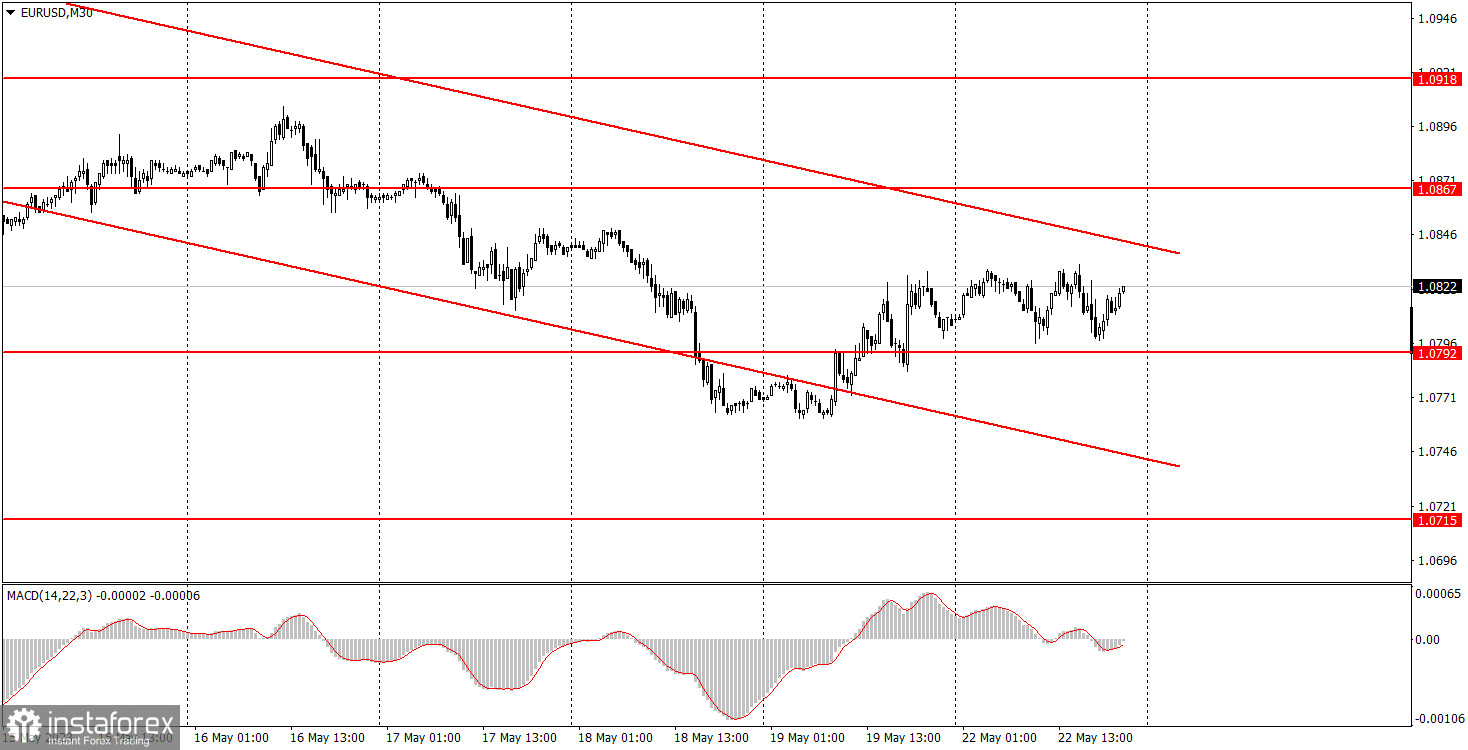Analysis of Monday trades
EUR/USD 30M chart

The EUR/USD currency pair traded in a very tight range on Monday. In the previous review, we predicted a dull Monday, and that's what really happened. Even three speeches by Federal Reserve Committee members or Treasury Secretary Janet Yellen did not manage to sparkle any significant movement in the pair. So, EUR/USD remains stuck in a descending channel, indicating that the downtrend is still intact. Unfortunately, this downtrend may persist even if the pair breaks out of the channel with a period of consolidation. In other words, the pair may move sideways, but that wouldn't mean the bearish trend has exhausted itself. However, it has not yet broken out of the channel, so it's too early to make such predictions. As before, we anticipate a further decline in the pair.
EUR/USD 5M chart

No signals were formed on the 5M timeframe on Monday. The pair approached the level of 1.0792 twice within a 4-pip range, but this was not enough to identify a signal clearly. Therefore, novice traders should not have opened any trades today. The pair remained in a flat range throughout the day, with volatility reaching 37 pips. In such conditions, trading would be senseless. We have made some adjustments to the levels on the 30M timeframe and recommend paying attention to them.
Trading plan on Tuesday:
On the 30M timeframe, the EUR/USD pair continued moving downward, taking a small pause during the day. The downward trend has been ongoing for over a week, which aligns with our expectations. It's worth noting that the pair had been rising for no good reason for two months, and now it's time for a correction. In the near future, an upward correction may occur, but the clear downward channel indicates the continuation of the trend. On the 5M timeframe, tomorrow's key levels are 1.0607-1.0613, 1.0715, 1.0761, 1.0792, 1.0857-1.0867, 1.0918-1.0933, and 1.0980. If the price moves 15 pips in the right direction, a stop-loss order can be placed at breakeven. On Tuesday, the European Union and the United States have planned releases of the service and manufacturing PMI's. These are not the most important indicators, so the market reaction may be weak. The US will also publish a report on new home sales, which is not a major report as well. Besides, there will be speeches by Federal Reserve representatives.
The basic principles of the trading system:
1) The strength of the signal depends on the time period during which the signal was formed (a rebound or a break). The shorter this period, the stronger the signal.
2) If two or more trades were opened at some level following false signals, i.e. those signals that did not lead the price to Take Profit level or the nearest target levels, then any consequent signals near this level should be ignored.
3) During the flat trend, any currency pair may form a lot of false signals or do not produce any signals at all. In any case, the flat trend is not the best condition for trading.
4) Trades are opened in the time period between the beginning of the European session and until the middle of the American one when all deals should be closed manually.
5) We can pay attention to the MACD signals in the 30M time frame only if there is good volatility and a definite trend confirmed by a trend line or a trend channel.
6) If two key levels are too close to each other (about 5-15 pips), then this is a support or resistance area.
How to read charts:
Support and Resistance price levels can serve as targets when buying or selling. You can place Take Profit levels near them.
Red lines are channels or trend lines that display the current trend and show which direction is better to trade.
MACD indicator (14,22,3) is a histogram and a signal line showing when it is better to enter the market when they cross. This indicator is better to be used in combination with trend channels or trend lines.
Important speeches and reports that are always reflected in the economic calendars can greatly influence the movement of a currency pair. Therefore, during such events, it is recommended to trade as carefully as possible or exit the market in order to avoid a sharp price reversal against the previous movement.
Beginning traders should remember that every trade cannot be profitable. The development of a reliable strategy and money management are the key to success in trading over a long period of time.





















